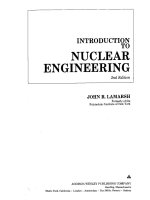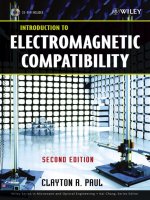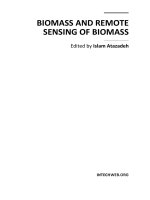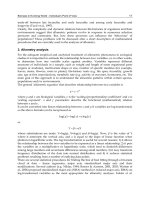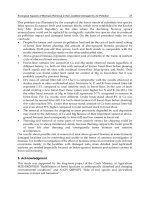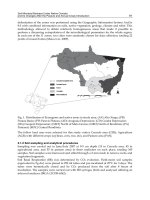- Trang chủ >>
- Khoa Học Tự Nhiên >>
- Vật lý
(Wiley series in atmospheric physics and remote sensing) claudio tomasi, sandro fuzzi, alexander kokhanovsky (eds ) atmospheric aerosols life cycles and effects on air quality and climate wiley v
Bạn đang xem bản rút gọn của tài liệu. Xem và tải ngay bản đầy đủ của tài liệu tại đây (20.53 MB, 700 trang )
Edited by
Claudio Tomasi, Sandro Fuzzi, and
Alexander Kokhanovsky
Atmospheric Aerosols
Wiley Series in Atmospheric Physics and Remote Sensing
Series Editor: Alexander Kokhanovsky
Wendisch, M. / Brenguier, J.-L. (eds.)
Huang, X. / Yang, P.
Airborne Measurements for
Environmental Research
Radiative Transfer Processes in
Weather and Climate Models
Methods and Instruments
2013
Coakley Jr., J. A. / Yang, P
Atmospheric Radiation
North, G. R. / Kim, K.-Y.
Energy Balance Climate
Models
A Primer with Illustrative Solutions
2014
Davis, A. B. / Marshak, A.
Stamnes, K. / Stamnes, J. J.
Multi-dimensional Radiative
Transfer
Radiative Transfer in Coupled
Environmental Systems
Theory, Observation, and Computation
An Introduction to Forward and Inverse
Modeling
Minnis, P. et al.
2015
Tomasi, C. / Fuzzi, S. / Kokhanovsky, A.
(eds.)
Satellite Remote Sensing of
Clouds
Atmospheric Aerosols
Life Cycles and Effects on Air Quality and
Climate
2016
Zhang, Z. et al.
Polarimetric Remote Sensing
Aerosols and Clouds
Forthcoming:
Kokhanovsky, A. / Natraj, V.
Analytical Methods in
Atmospheric Radiative
Transfer
Weng, F.
Satellite Microwave Remote
Sensing
Fundamentals and Applications
Edited by Claudio Tomasi, Sandro Fuzzi, and
Alexander Kokhanovsky
Atmospheric Aerosols
Life Cycles and Effects on Air Quality and Climate
The Editors
Institute of Atmospheric Sciences &
Climate ISAC
Area della Ricerca del CNR
Via Gobetti 101
40129 Bologna
Italy
All books published by Wiley-VCH are
carefully produced. Nevertheless, authors,
editors, and publisher do not warrant the
information contained in these books,
including this book, to be free of errors.
Readers are advised to keep in mind that
statements, data, illustrations, procedural
details or other items may inadvertently
be inaccurate.
Prof. Sandro Fuzzi
Library of Congress Card No.: applied for
Prof. Claudio Tomasi
Institute of Atmospheric Sciences &
Climate ISAC
Area della Ricerca del CNR
Via Gobetti 101
40129 Bologna
Italy
British Library Cataloguing-in-Publication
Data
A catalogue record for this book is available from the British Library.
Dr. Alexander Kokhanovsky
Bibliographic information published by the
Deutsche Nationalbibliothek
EUMETSAT
Remote sensing Products
EUMETSAT-Allee 1
64295 Darmstadt
Germany
The Deutsche Nationalbibliothek
lists this publication in the Deutsche
Nationalbibliografie; detailed
bibliographic data are available on the
Internet at <>.
and
Moscow Engineering Physics Institute
(MEPhI)
National Research Nuclear University
Kashirskoe Str. 31
115 409 Moscow
Russia
A book of the Wiley Series in Atmospheric
Physics and Remote Sensing
The Series Editor
Dr. Alexander Kokhanovsky
EUMETSAT
Remote sensing Products
EUMETSAT-Allee 1
64295 Darmstadt
Germany
© 2017 Wiley-VCH Verlag GmbH & Co.
KGaA, Boschstr. 12, 69469 Weinheim,
Germany
All rights reserved (including those of
translation into other languages). No part
of this book may be reproduced in any
form – by photoprinting, microfilm, or
any other means – nor transmitted or
translated into a machine language
without written permission from the
publishers. Registered names, trademarks,
etc. used in this book, even when not
specifically marked as such, are not to be
considered unprotected by law.
Print ISBN: 978-3-527-33645-6
ePDF ISBN: 978-3-527-33643-2
ePub ISBN: 978-3-527-33641-8
Mobi ISBN: 978-3-527-33642-5
oBook ISBN: 978-3-527-33644-9
and
Moscow Engineering Physics Institute
(MEPhI)
National Research Nuclear University
Kashirskoe Str. 31
115 409 Moscow
Russia
Cover
NASA
Cover Design Grafik-Design Schulz
Typesetting SPi Global, Chennai, India
Printing and Binding
Printed on acid-free paper
V
Contents
List of Contributors XV
Preface XIX
Foreword XXI
Acknowledgments XXIII
1
Primary and Secondary Sources of Atmospheric Aerosol 1
Claudio Tomasi and Angelo Lupi
1.1
1.2
1.3
1.3.1
1.3.2
1.3.3
1.3.4
1.3.5
1.3.6
1.4
1.4.1
Introduction 1
A General Classification of Aerosol Sources 6
Primary Aerosols of Natural Origin 7
Sea-Salt Particles 8
Mineral Dust 13
Biogenic Aerosols 20
Forest Fire Smoke 23
Volcanic Dust in the Troposphere 27
Cosmic Dust 30
Secondary Aerosols of Natural Origin 31
Natural Sulfate Particles from Tropospheric SO2 and Sulfur
Compounds 32
Natural Nitrate Particles from Tropospheric Nitrogen Oxides 37
Organic Aerosols from Biogenic Volatile Organic Compounds 41
Sulfate Particles from Marine and Volcanic SO2 Formed in the
Stratosphere 42
Primary Anthropogenic Aerosols 48
Industrial Dust 50
Anthropogenic Aerosols from Fossil Fuel Combustion and
Carbonaceous (Soot) Particles 51
Anthropogenic Aerosols from Waste and Biomass Burning 58
Secondary Anthropogenic Aerosols 59
Secondary Particles from SO2 60
Secondary Particles from NOx 64
Secondary Organic Aerosols 68
1.4.2
1.4.3
1.4.4
1.5
1.5.1
1.5.2
1.5.3
1.6
1.6.1
1.6.2
1.6.3
VI
Contents
1.7
Concluding Remarks on the Global Annual Emission Fluxes of
Natural and Anthropogenic Aerosol Mass 70
Abbreviations 75
List of Symbols 75
References 76
2
Aerosol Nucleation in the Terrestrial Atmosphere 87
Karine Sellegri and Julien Boulon
2.1
2.2
Introduction 87
Theoretical Basis of Nucleation and Growth of New Particles in the
Atmosphere 88
Introduction to Nucleation Theories Useful in Atmospheric
Sciences 88
The Unary System Model 89
The H2 SO4 −H2 O Binary System 91
The H2 SO4 −NH3 −H2 O Ternary System 93
The Role of Amines 93
The Ion-Induced Nucleation 94
The Growth of New Particles 95
The Condensation Process 95
Observation and Detection Tools 97
Detection Tools 98
Physical Characterization 98
Chemical Characterization 99
Metrics for Characterizing New Particle Formation Events 100
Occurrence of New Particle Formation Events in the
Troposphere 102
Pristine and Polluted Continental Boundary Layer 102
Coastal and Marine Boundary Layer Sites 103
High-Altitude Environments and Free Troposphere 103
Precursor Candidates for Nucleation and Early Growth from
Observations 104
Continental Planetary Boundary Layer 104
Marine Planetary Boundary Layer 104
Parameterizations and Chamber Experiments 105
Importance of Nucleation for the Production of Aerosols and CCN at
the Global Scale 107
Conclusions 108
Abbreviations 109
List of Symbols 110
References 110
2.2.1
2.2.1.1
2.2.1.2
2.2.1.3
2.2.1.4
2.2.1.5
2.2.2
2.2.2.1
2.3
2.3.1
2.3.1.1
2.3.1.2
2.3.2
2.3.3
2.3.3.1
2.3.3.2
2.3.3.3
2.4
2.4.1
2.4.2
2.5
2.6
2.7
3
Coagulation, Condensation, Dry and Wet Deposition, and Cloud
Droplet Formation in the Atmospheric Aerosol Life Cycle 115
Claudio Tomasi and Angelo Lupi
3.1
Introduction 115
Contents
3.2
3.2.1
3.2.2
3.2.3
3.2.4
3.3
3.3.1
3.3.2
3.3.2.1
3.3.2.2
3.3.2.3
3.3.2.4
3.3.2.5
3.4
3.4.1
3.4.2
3.4.3
3.5
Physical Growth Processes 120
Brownian Coagulation 121
Growth by Condensation of Gases onto Preexisting Particles
The Kelvin Effect 130
Hygroscopic Growth of Particles by Water Vapor
Condensation 133
Aerosol Removal Processes 139
Dry Deposition of Aerosol Particles 141
Wet Deposition of Aerosol Particles 144
In-Cloud Scavenging (Rainout) 145
Interstitial Aerosol Scavenging by Cloud Droplets 147
Precipitation Scavenging 149
Wet Deposition in Fogs 157
Nucleation of Ice Particles 157
Formation of Cloud Particles 161
Water Vapor Condensation 162
The Köhler Theory 163
The Cloud Condensation Nuclei 169
Concluding Remarks 170
Abbreviations 175
List of Symbols 175
References 180
128
4
Chemical Composition of Aerosols of Different Origin 183
Stefania Gilardoni and Sandro Fuzzi
4.1
4.2
Introduction 183
Global Distribution and Climatology of the Main Aerosol Chemical
Constituents 184
Definition of Primary and Secondary Inorganic and Organic Aerosol
Compounds 184
Aerosol Global Budgets 186
Organic Aerosol 186
Black Carbon Aerosol 187
Sulfur Aerosol 188
Nitrogen Aerosol Species 189
Dust Aerosol 191
Main Regional Differences and Seasonal Variations of Aerosol
Chemical Composition 192
Urban Aerosol 192
Rural Aerosol 193
Continental Regional Background Aerosol 194
Marine Background Aerosol 195
Size Distributions of Aerosol Chemical Compounds 196
Aerosol Size-Resolved Chemical Composition in Polluted
Areas 196
4.2.1
4.2.2
4.2.2.1
4.2.2.2
4.2.2.3
4.2.2.4
4.2.2.5
4.2.3
4.2.3.1
4.2.3.2
4.2.3.3
4.2.3.4
4.3
4.3.1
VII
VIII
Contents
4.3.1.1
4.3.1.2
4.3.1.3
4.3.1.4
4.3.2
4.3.2.1
4.3.2.2
4.3.2.3
4.3.3
4.4
4.4.1
4.4.1.1
4.4.1.2
4.4.2
4.4.2.1
4.4.2.2
4.4.3
4.4.3.1
4.4.3.2
Secondary Inorganic Aerosol (Ammonium Sulfate and Nitrate) 197
Organic Aerosol 197
Black Carbon 198
Dust 200
Aerosol Size-Resolved Chemical Composition in Unperturbed
Environments 200
Rain Forest 200
High Altitude Mountain Regions 200
Polar Regions 202
Long-Term Changes of Aerosol Chemical Components 203
Issues Related to Aerosol Chemical Composition 205
Characterization of the Aerosol Carbonaceous Fraction 205
Soot: BC or EC 205
Organic Aerosol 207
Sources of BC and OA 209
Black Carbon 209
Organic Aerosol 211
Effect of Organic and Inorganic Chemical Composition on Aerosol
Activity as Cloud Condensation Nuclei and Ice Nuclei 213
Cloud Condensation Nuclei 213
Ice Nuclei 214
Abbreviations 216
List of Symbols 217
References 218
5
Aerosol Optics 223
Alexander A. Kokhanovsky
5.1
5.2
5.3
5.4
5.5
5.6
5.7
Introduction 223
Absorption 224
Scattering 229
Polarization 234
Extinction 237
Radiative Transfer 239
Image Transfer 242
Abbreviations 244
List of Symbols 244
References 245
6
Aerosol Models 247
Claudio Tomasi, Mauro Mazzola, Christian Lanconelli, and Angelo Lupi
6.1
6.2
Introduction 247
Modeling of the Optical and Microphysical Characteristics of
Atmospheric Aerosol 249
The 6S Code Aerosol Extinction Models 254
6.2.1
Contents
6.2.1.1
6.2.1.2
6.2.2
6.2.3
6.2.4
6.2.5
6.2.6
6.2.7
6.3
6.3.1
6.3.2
6.4
6.4.1
6.4.2
6.4.3
6.4.4
6.4.5
6.4.6
6.4.7
6.4.8
6.4.9
6.4.10
6.4.11
6.4.12
6.5
The Four 6S Basic Aerosol Components 254
The Three 6S Aerosol Models 258
The 6S Additional Aerosol Models 262
The 6S Modified (M-Type) Aerosol Models 271
The OPAC Aerosol Models 277
The Aerosol Models of Shettle and Fenn (1979) 288
The Seven Additional Aerosol Models of Tomasi et al. (2013) 295
The Polar Aerosol Models 304
General Remarks on the Aerosol Particle Number, Surface, and
Volume Size-Distribution Functions 306
The Aerosol Particle Number Size-Distribution Function 310
The Aerosol Surface, Volume, and Mass Size Distributions 314
Size-Distribution Characteristics of Various Aerosol Types 317
Remote Continental Aerosols 317
Free Tropospheric Aerosols 319
Rural-Continental Aerosols 319
Continental-Polluted Aerosols 322
Maritime Clean Aerosols 322
Maritime-Polluted Aerosols 324
Desert Dust 324
Biomass Burning Aerosols 326
Urban Aerosols 326
Polar Arctic Aerosols 328
Polar Antarctic Aerosols 329
Stratospheric Volcanic Aerosols 331
Concluding Remarks 332
Abbreviations 333
List of Symbols 334
References 337
7
Remote Sensing of Atmospheric Aerosol 341
Alexander A. Kokhanovsky, Claudio Tomasi, Boyan H. Petkov,
Christian Lanconelli, Maurizio Busetto, Mauro Mazzola, Angelo Lupi, and
Kwon H. Lee
7.1
7.2
7.2.1
7.2.1.1
Introduction 341
Ground-Based Aerosol Remote Sensing Measurements 342
The Multispectral Sun-Photometry Method 345
Calibration of a Sun Photometer Using the Langley Plot
Method 346
Determination of Aerosol Optical Thickness 348
Determination of Aerosol Optical Parameters from Sun-Photometer
Measurements 360
˚
Relationship between the Fine Particle Fraction and Angström
Wavelength Exponent 370
7.2.1.2
7.2.1.3
7.2.1.4
IX
X
Contents
7.2.2
7.2.3
7.2.4
7.3
7.3.1
7.3.2
7.3.3
7.3.4
7.3.5
7.3.6
7.3.7
7.3.8
7.4
7.4.1
7.4.2
7.4.2.1
7.4.2.2
7.4.2.3
7.4.2.4
7.4.2.5
7.4.2.6
7.4.2.7
7.4.3
7.4.3.1
7.4.3.2
7.4.3.3
Measurements of Volume Extinction, Scattering, and Absorption
Coefficients at Ground Level Using Nephelometer and PSAP
Techniques 373
Vertical Profiles of Backscatter and Extinction Coefficients from
LIDAR Measurements 375
Measurements of the Aerosol Size Distribution Using an Optical
Particle Counter 378
Airborne Remote Sensing Measurements of Aerosol Optical
Properties 380
Main Results Derived from the Second Airborne Arctic
Stratospheric Expedition (AASE-II) Measurements 385
Airborne Remote Sensing Measurements during the Army LIDAR
Verification Experiment (ALIVE) 386
Airborne Measurements Performed during the Sulfate Clouds and
Radiation–Atlantic (SCAR-A) Experiment 386
Airborne Measurements Conducted during the Tropospheric
Aerosol Radiative Forcing Observational Experiment
(TARFOX) 387
The Aerosol Characterization Experiment 2 (ACE-2) Airborne
Remote Sensing Measurements 388
Airborne Remote Sensing Measurements during the Puerto Rico
Dust Experiment (PRIDE) 391
The ARCTAS/ARCPAC Airborne Remote Sensing Measurements in
the Western Arctic 392
The Airborne Measurements Conducted during the Pan-Arctic
Measurements and Arctic Regional Climate Model Intercomparison
Project (PAM-ARCMIP) 399
Satellite-Borne Aerosol Remote Sensing Measurements 403
Satellite Instrumentation 403
Methods 411
The Algorithms Based on the Single-View Spectral
Observations 411
Double-View Spectral Observations 412
Multiview Spectral Observations 413
Multiview Spectral and Polarimetric Observations 413
Retrievals over Ocean Using Multiangle Polarimetric
Observations 414
Retrievals over Land 414
Aerosol Retrieval Using an Artificial Neural Network
Technique 414
Examples of Aerosol Retrievals 415
Global View of Aerosol Distribution from Passive Sensor 415
Aerosol Retrieval from Different Sensors and Retrieval
Algorithms 416
Time-Resolved Observation from Geostationary Platform 419
Contents
7.4.3.4
Atmospheric Anatomy from the Active Sensing Platform 421
Abbreviations 422
List of Symbols 423
References 427
8
Aerosol and Climate Change: Direct and Indirect Aerosol Effects on
Climate 437
Claudio Tomasi, Christian Lanconelli, Mauro Mazzola, and Angelo Lupi
8.1
8.2
Introduction 437
The Instantaneous DARF Effects at the ToA and BoA Levels and in
the Atmosphere 439
The Spectral Characteristics of Solar Radiation 439
Vertical Features of Aerosol Volume Extinction Coefficient 443
Aerosol Extinction Models and Optical Characteristics 444
Modeling the Underlying Surface Reflectance Characteristics 447
Calculations of Instantaneous DARF Terms at the ToA and BoA
Levels and within the Atmosphere 459
Dependence Features of Instantaneous DARF Terms on Aerosol
Optical Parameters and Surface Reflectance 463
Dependence of Instantaneous DARF on Aerosol Optical
Thickness 464
Dependence of Instantaneous DARF on Aerosol Single Scattering
Albedo 467
Dependence of Instantaneous DARF on Underlying Surface
Albedo 471
Dependence of Instantaneous DARF on Solar Zenith Angle 474
The Diurnally Average DARF Induced by Various Aerosol Types over
Ocean and Land Surfaces 476
Description of the Calculation Method Based on the Field
Measurements of Aerosol Optical Parameters 478
Calculations of the Diurnally Average DARF Terms and Efficiency
Parameters for Eleven Aerosol Types 498
Remote Continental Aerosols 498
Rural-Continental Aerosols 500
Free Tropospheric Aerosols 502
Continental-Polluted Aerosols 504
Maritime Clean Aerosols 506
Maritime–Continental Aerosols 508
Desert Dust 512
Biomass Burning Aerosols 516
Urban and Industrial Aerosols 519
Polar Aerosols 522
Stratospheric Volcanic Aerosols 525
Variations of DARF Efficiency as a Function of Aerosol Single
Scattering Albedo 525
8.2.1
8.2.2
8.2.3
8.2.4
8.2.5
8.2.6
8.2.6.1
8.2.6.2
8.2.6.3
8.2.6.4
8.3
8.3.1
8.3.2
8.3.2.1
8.3.2.2
8.3.2.3
8.3.2.4
8.3.2.5
8.3.2.6
8.3.2.7
8.3.2.8
8.3.2.9
8.3.2.10
8.3.2.11
8.4
XI
XII
Contents
8.5
8.6
Concluding Remarks on the DARF Effects over the Global
Scale 529
On the Indirect Aerosol Effects Acting in the Earth’s Climate
System 531
Abbreviations 537
List of Symbols 538
References 541
9
Aerosol and Air Quality 553
Sandro Fuzzi, Stefania Gilardoni, Alexander A. Kokhanovsky, Walter Di
Nicolantonio, Sonoyo Mukai, Itaru Sano, Makiko Nakata, Claudio Tomasi,
and Christian Lanconelli
9.1
9.1.1
9.1.2
Introduction 553
Aerosol Air Pollution 553
Aerosol Sources and Size Distribution in Relation to Human Health
Effects 553
Aerosol Chemical Composition and Health Effects 555
Atmospheric Aerosols, Air Pollution, and Climate Change 557
Aerosol Load in Different Areas of the World 558
Aerosol Load as Derived from Satellite-Based Measurements 560
VIS/NIR/SWIR Multispectral Satellite Observations for
Evaluating PM Concentrations: An Example over the Northern
Italy Area 560
MODIS-Based PM Concentration Estimates at the Surface 561
Data Set and Results 563
Satellite PM Multiannual Monitoring: Looking for Compliance to
European Air Quality Directive 566
PM Estimations over Osaka (Japan) Based on Satellite
Observations 569
Introduction 569
Aerosol Remote Sensing 571
Estimation of PM from Satellite-Based AOT 574
Characterization of Mass Concentration and Optical Properties of
Desert Dust in Different Areas of the Earth 577
Dust Storms in the Southwestern United States 578
Saharan Dust Transport over the Southeastern United States and the
Caribbean Region 579
Saharan Dust Transport over the Tropical Atlantic Ocean and the
Western Coast of Africa 580
Saharan Dust Transport Toward Southern Europe 581
Saharan Dust Transport Toward the Middle Eastern and the Persian
Gulf 584
Asian Dust Transport Over Central Asia and China 584
Asian Dust Transport Over Korea and Japan 588
Desert Dust Transport Over Oceanic Areas 589
9.1.3
9.1.4
9.1.5
9.2
9.2.1
9.2.1.1
9.2.1.2
9.2.1.3
9.2.2
9.2.2.1
9.2.2.2
9.2.2.3
9.3
9.3.1
9.3.2
9.3.3
9.3.4
9.3.5
9.3.6
9.3.7
9.3.8
Contents
Abbreviations 589
List of Symbols 590
References 591
10
Impact of the Airborne Particulate Matter on the Human Health 597
Marina Camatini, Maurizio Gualtieri, and Giulio Sancini
10.1
10.2
10.2.1
10.2.2
10.2.3
10.3
10.3.1
10.3.2
10.3.2.1
10.3.2.2
10.3.2.3
10.3.3
10.3.3.1
10.3.3.2
10.3.3.3
10.3.3.4
10.4
10.4.1
10.4.2
10.4.3
10.4.4
10.5
Introduction 597
Epidemiological Evidences 600
Exacerbation of Lung Diseases 602
Effects on the Cardiovascular System 603
Life Expectancy and PM Concentration 606
Toxicological Evidences 609
Particle Dosimetry, Particle Deposition, and Real Exposure 609
In Vivo Evidences 612
Lung Inflammation 613
Cardiovascular Damages 615
Brain and Other Target Organs 618
In Vitro Evidences 622
Inflammatory Response 622
Oxidative Stress 624
DNA Damage 626
Cell Death 627
Mechanism of Effects 630
The Inflammatory Paradigm 630
The Reactive Oxygen Species 632
Translocation of Particles: If Yes Then Where 634
Dimension versus Composition: Two Heads of the “PM Hydra” 636
Conclusions 637
Abbreviations 638
List of Symbols 639
References 639
11
Aerosol Impact on Cultural Heritage: Deterioration Processes and
Strategies for Preventive Conservation 645
Alessandra Bonazza, Paola De Nuntiis, Paolo Mandrioli, and
Cristina Sabbioni
11.1
11.2
11.3
11.3.1
11.3.2
11.3.3
11.3.4
11.3.5
11.4
Introduction 645
Monitoring for Cultural Heritage Conservation 645
Damage and Black Crusts Formation on Building Materials 652
Damage to Carbonate Stone 653
Damage to Silicate Stone 655
Anthropogenic Aerosol in Crusts 656
Organic and Elemental Carbon 657
Damage to Coastal Areas 658
Bioaerosol Effects on Cultural Heritage 659
XIII
XIV
Contents
11.5
Guidelines for the Preventive Conservation of Cultural Heritage in
Urban Areas 664
Abbreviations 665
List of Symbols 665
References 666
Index 671
XV
List of Contributors
Alessandra Bonazza
Marina Camatini
Institute of Atmospheric
Sciences and Climate (ISAC)
National Research Council of
Italy (CNR)
Via Gobetti 101
40129 Bologna
Italy
University of Milano Bicocca
POLARIS Research Centre
Department of Environmental
Science
Piazza della Scienza 1
20126 Milano
Italy
Julien Boulon
Paola De Nuntiis
Université Paul Sabatier
Institut de Recherche en
Astrophysique et Planetologie
(IRAP)
CNRS-UMR5277
14 avenue E. Belin
31400 Toulouse
France
Institute of Atmospheric
Sciences and Climate (ISAC)
National Research Council of
Italy (CNR)
Via Gobetti 101
40129 Bologna
Italy
Sandro Fuzzi
Maurizio Busetto
Institute of Atmospheric
Sciences and Climate (ISAC)
National Research Council of
Italy (CNR)
Via Gobetti 101
40129 Bologna
Italy
Institute of Atmospheric
Sciences and Climate (ISAC)
National Research Council of
Italy (CNR)
Via Gobetti 101
40129 Bologna
Italy
XVI
List of Contributors
Stefania Gilardoni
Kwon H. Lee
Institute of Atmospheric
Sciences and Climate (ISAC)
National Research Council of
Italy (CNR)
Via Gobetti 101
40129 Bologna
Italy
Gangneung-Wonju National
University (GWNU)
Department of Atmospheric and
Environmental Sciences
7 Jukheon-gil
Gangneung, Gwangwondo 25457
Republic of Korea
Maurizio Gualtieri
Angelo Lupi
Italian National Agency for New
Technologies
Energy and Sustainable
Economic Development
(ENEA)-SSPT-MET-INAT
POLARIS Research Centre
40129 Bologna
Italy
Institute of Atmospheric
Sciences and Climate (ISAC)
National Research Council of
Italy (CNR)
Via Gobetti 101
40129 Bologna
Italy
Paolo Mandrioli
Alexander A. Kokhanovsky
EUMETSAT
Remote Sensing Products
EUMETSAT Allee 1
D64295 Darmstadt
Germany
Institute of Atmospheric
Sciences and Climate (ISAC)
National Research Council of
Italy (CNR)
Via Gobetti 101
40129 Bologna
Italy
and
Mauro Mazzola
National Research Nuclear
University
Moscow Engineering Physics
Institute (MEPhI)
Kashirskoe Str. 31
115 409 Moscow
Russia
Institute of Atmospheric
Sciences and Climate (ISAC)
National Research Council of
Italy (CNR)
Via Gobetti 101
40129 Bologna
Italy
Christian Lanconelli
Sonoyo Mukai
Institute of Atmospheric
Sciences and Climate (ISAC)
National Research Council of
Italy (CNR)
Via Gobetti 101
40129 Bologna
Italy
The Kyoto College of Graduate
Studies for Informatics
7 Tanaka Monzencho
Sakyo
Kyoto 606-8225
Japan
List of Contributors
Makiko Nakata
Giulio Sancini
Kindai University
3-4-1 Kowakae
Higashi-Osaka
Osaka 577-8502
Japan
University of Milano Bicocca
POLARIS Research Centre
School of Medicine and Surgery
20900 Monza
Italy
Walter Di Nicolantonio
Itaru Sano
CGS S.p.A – Compagnia
Generale per lo Spazio
OHB SE Company
Department of Satellites and
Missions
via Gallarate 150
20151 Milan
Italy
Kindai University
3-4-1 Kowakae
Higashi-Osaka
Osaka 577–8502
Japan
Boyan H. Petkov
Institute of Atmospheric
Sciences and Climate (ISAC)
National Research Council of
Italy (CNR)
Via Gobetti 101
40129 Bologna
Italy
Cristina Sabbioni
Institute of Atmospheric
Sciences and Climate (ISAC)
National Research Council of
Italy (CNR)
Via Gobetti 101
40129 Bologna
Italy
Karine Sellegri
Université Blaise Pascal
Laboratoire de Météorologie
Physique (LaMP)
CNRS-UMR 6016
4 avenue Blaise Pascal
63170 Aubière
France
Claudio Tomasi
Institute of Atmospheric
Sciences and Climate (ISAC)
National Research Council of
Italy (CNR)
Via Gobetti 101
40129 Bologna
Italy
XVII
XIX
Preface
Atmospheric aerosol, also commonly called airborne particulate matter (PM), is
a subject of extensive research that, since the beginning of the 1980s, has received
increased attention from the atmospheric science community. This is in part
due to the enormous advances in measurement technologies from that period,
which have allowed for an increasingly accurate understanding of the chemical
composition and of the physical properties of atmospheric aerosol and its life
cycle in the atmosphere.
The growing scientific interest in atmospheric aerosol is also due to its high
importance for environmental policy. In fact, PM constitutes one of the most
challenging problems both for air quality and for climate change policies.
Atmospheric aerosol affects air quality and, in turn, human and ecosystem
well-being and also have an important role in the Earth’s climate system. Understanding of aerosol nucleation, emission, deposition, transport, and life cycle
is probably the most pressing issue in air quality regulation worldwide, and at
the same time it represents one of the biggest sources of uncertainty in current
climate simulations.
This book, which collects contributions from an international team of scientists
with different backgrounds, is aimed at providing an overall interdisciplinary
picture of the aerosol lifecycle, from nucleation and emission to atmospheric
processing. Also, the measurement techniques and the aerosol environmental
effects are discussed.
The first chapter of the book provides an overview of the main sources of
atmospheric aerosol, both primary and secondary and of natural and anthropogenic origin.
Chapters 2 and 3 describe the atmospheric processing and removal of aerosol:
new particle formation, coagulation and condensation processes, wet and dry
deposition, and aerosol–cloud interaction.
Chapter 4 provides an overview of the chemical climatology of atmospheric
aerosol and of some emerging issues in aerosol science such as the nature and
processes of organic aerosol and the chemical properties of aerosol affecting their
cloud condensation nuclei (CCN) and ice nuclei (IN) ability.
Chapter 5 introduces the basic elements of aerosol optics which are needed for
the understanding of aerosol radiation transfer modelling (Chapter 6) and the
XX
Preface
remote sensing of atmospheric aerosol both from ground-based measurements
and from airborne and space platforms (Chapter 7). This latter chapter also provides useful examples of international aerosol remote sensing experiments carried
out in different regions of the world.
Chapter 8 addresses the role of aerosol on climate, both in terms of direct (i.e.,
radiation scattering and absorption properties of aerosol particles) and indirect
(i.e., the effect of aerosol on cloud structure and radiative properties acting as CCN
and IN) effects.
Chapter 9 examines the effects of aerosol on air quality and the interactions
between air quality and climate, the retrieval of aerosol data from satellite measurements, and a characterization of mass concentration and optical properties of
desert dust in different areas of the Earth.
Chapter 10 then describes the effects of PM on human health, both in terms of
epidemiology and toxicology, the quantification of human exposure to particulate
pollutants, and the mechanisms and effects of the interaction between PM and
the human body.
The last chapter addresses an aspect rarely discussed in books of aerosol science,
that is, the effects of aerosols that cause damage to heritage materials, both indoor
and outdoor: monumental complexes, archaeological sites, and heritage objects.
The chapter describes the monitoring of the damages; the physical, chemical, and
biological mechanisms of interaction between atmospheric aerosols and cultural
heritage material; and the guidelines for the conservation of cultural heritage.
We wish to thank all colleagues who have contributed to the book and have
provided such a wide and interdisciplinary overview on atmospheric aerosol: their
origin, processing in the atmosphere, measurement techniques, and environmental effects. We also wish to thank Prof. Teruyuki Nakajima for having kindly agreed
to write the foreword to this book.
Bologna
August 1, 2016
Claudio Tomasi
Sandro Fuzzi
Alexander Kokhanovsky
XXI
Foreword
Atmospheric aerosol composed of small liquid and solid particles suspended in
air is an important atmospheric constituent that has always attracted scientific
research. It impacts various phenomena on earth, including atmospheric chemistry, cloud and rain, climate, health, and biological activity among others. In the
1950s–1960s, urban air pollution, causing phenomenon such as the Los Angeles
City smog, posed a serious social problem. Hence, understanding the atmospheric chemical reactions and aerosol properties was an urgent requirement
for the research community to focus on. During this period, basic atmospheric
chemistry was conceptualized. In the 1980s–1990s, aerosols received growing
attention from the climate researchers owing to global warming. In this period,
climate and aerosol researchers collaborated to develop climate models that take
into account aerosols and other chemical species. They found that aerosols affect
the earth’s climate directly through their radiative effect and indirectly through
their interactions with the cloud system. The net radiative forcing of aerosols
was estimated to be negative, that means cooling of the earth system, but the
estimated uncertainty was significantly large. Satellite remote sensing also flourished during this period, and a global perspective of the aerosol phenomena was
conceived, such as continental-scale transportation of dust and other particles
and change in the cloud droplet size on interacting with aerosols.
The current era is known as the era of human beings or Anthropocene, as
coined by the Nobel laureate Paul Crutzen. This era is marked by human activities
changing the earth on a scale observable from the space. The United Nation’s
Sustainable Development Goals (SDGs) have outlined the prioritization scheme
for the maximization of the benefits of symbiotic coexistence with nature. In this
era, aerosol science can provide a solution for various aerosol-related problems
by linking various processes of different scales, such as microphysical, chemical,
mesoscale, cloud, and global processes. High-resolution modelling of the weather,
cloud, and rain considers aerosols as the cloud condensation nuclei (CCN) and
radiative forcing agent to improve the weather forecasting for disaster prevention.
A data assimilation system has been developed to utilize the data from groundbased networks and satellites along with model simulations for providing useful
information on the air quality to regulate and evaluate its public health impact.
XXII
Foreword
As described above, aerosol-related sciences have become an important
research field. In this regard, I am pleased to see that this book is being published.
It includes the widespread effects of aerosols, which is otherwise difficult to
fully understand without a well-organized textbook. This book provides a comprehensive knowledge of aerosol science. It covers almost everything from the
basic concepts to various applications and from theoretical bases to observations
with well-organized equations, figures, and tables to provide the readers with a
quantitative approach to the subject.
I believe this book will provide the readers a great opportunity to explore the
wonders of aerosol science.
Teruyuki Nakajima
Earth Observation Research Center
JAXA, Tsukuba, Japan
XXIII
Acknowledgments
Claudio Tomasi and Angelo Lupi gratefully acknowledge the colleagues Cristina
Sabbioni, Paolo Mandrioli, and Alessandra Bonazza (Institute of Atmospheric
Sciences and Climate, ISAC – C.N.R., Bologna, Italy); Emanuela Molinaroli
(Department of Environmental Sciences, University of Venice, Italy); Angelo Ibba
(Department of Earth Sciences, University of Cagliari, Italy); Annie Gaudichet
(LISA, Paris University, France); and Hélène Cachier (LSCE/IPSL, Gif-sur-Yvette,
France) for providing the scanning electron microscopy (SEM) and transmission
electron microscopy (TEM) images of aerosol particles shown in Figures 1.4, 1.7,
1.8, and 1.11 of Chapter 1.
Sandro Fuzzi and Stefania Gilardoni acknowledge the support of the European
Projects ACCENT (Atmospheric Composition Change: the European Network)
and ACCENT-Plus (Atmospheric Composition Change: the European NetworkPolicy Support and Science) for the preparation of Chapter 4 and part of Chapter 9.
Alexander Kokhanovsky acknowledges support of the excellence center for
applied mathematics and theoretical physics within MEPhI Academic Excellence
Project (contract No. 02.a03.21.0005, 27.08.2013). He is grateful to his former
colleagues at the Institute of Physics in Minsk (Belarus) and also at the Institute
of Environmental Physics (Bremen, Germany) for discussions on various aspects
of radiative transfer, satellite atmospheric optics, and atmospheric aerosol. A
lot of insights in aerosol optics, image transfer, and radiative transfer have been
gained via joint work with Eleonora Zege, Vladimir Rozanov, Wolfgang von
Hoyningen-Huene, Gerrit de Leeuw, Teruyuki Nakajima, Reiner Weichert, Alan
Jones, and John Burrows.
Claudio Tomasi, Boyan H. Petkov, Christian Lanconelli, Maurizio Busetto,
Mauro Mazzola, Angelo Lupi, Alexander Kokhanovsky, and Kwon H. Lee
acknowledge the colleagues G. P. Gobbi and F. Angelini (Institute of Atmospheric
Sciences and Climate, ISAC – C.N.R., Rome Tor Vergata, Italy), for providing the
automated Vaisala LD-40 ceilometer data set collected at the Torre Sarca (University of Milano-Bicocca) station in the center of Milan (Italy) during the QUITSAT
field campaigns of summer 2007 and winter 2008, and the colleagues Ezio Bolzacchini and Luca Ferrero (Dept. of Earth and Environmental Sciences, University of
Milano-Bicocca, Milan, Italy) for providing the OPC (1.108 “Dustcheck” GRIMM
model) data set collected at the Torre Sarca (Milano-Bicocca University) station
XXIV
Acknowledgments
in the center of Milan (Italy) during the three years from 2005 to 2008, which
have been examined in Chapter 7. K.H. Lee’s work was funded by the Korean
Meteorological Administration Research and Development Program under
Grant KMIPA2015-2012.
Marina Camatini, Maurizio Gualtieri, and Giulio Sancini of the POLARIS
Research Centre (University of Milano-Bicocca, Milan, Italy) acknowledge Dr.
Laura Capasso (POLARIS Research Centre), who has realized some figures
shown in Chapter 10.
1
1
Primary and Secondary Sources of Atmospheric Aerosol
Claudio Tomasi and Angelo Lupi
1.1
Introduction
Atmospheric aerosols are suspensions of any substance existing in the solid
and/or liquid phase in the atmosphere (except pure water) under normal conditions and having a minimum stability in air assuring an atmospheric lifetime of at
least 1 h. Generated by natural sources (i.e., wind-borne dust, sea spray, volcanic
debris, biogenic aerosol) and/or anthropogenic activities (i.e., sulfates and nitrates
from industrial emissions, wind-forced mineral dust mobilized in areas exploited
for agricultural activities, fossil fuel combustion, and waste and biomass burning),
aerosol particles range in size from a few nanometers to several tens of microns.
As a result of internal cohesive forces and their negligible terminal fall speeds,
aerosol particles can first assume sizes appreciably larger than the most common
air molecules and subsequently increase to reach sizes ranging most frequently
from less than 10−3 to no more than 100 μm (Heintzenberg, 1994). Particles with
sizes smaller than 20–30 Å (1 Å = 10−10 m) are usually classified as clusters or
small ions, while mineral and tropospheric volcanic dust particles with sizes
greater than a few hundred microns are not considered to belong to the coarse
aerosol class, since they have very short lifetimes. Aerosol particles grown by condensation to become cloud droplets are not classified as aerosols, although a cloud
droplet needs a relatively small aerosol particle acting as a condensation nucleus
for its formation under normal atmospheric conditions. Similarly, precipitation
elements such as rain droplets, snowflakes, and ice crystals are not classified as
aerosols (Heintzenberg, 1994). Although present in considerably lower concentrations than those of the main air molecules, aerosol particles play a very important
role in numerous meteorological, physical, and chemical processes occurring in
the atmosphere, such as the electrical conductivity of air, condensation of water
vapor on small nuclei and subsequent formation of fog and cloud droplets, acid
rains, scattering, and absorption of both incoming solar (shortwave) radiation
and thermal terrestrial (longwave) radiation. The interaction processes between
atmospheric aerosols and the downwelling and upwelling radiation fluxes of solar
Atmospheric Aerosols: Life Cycles and Effects on Air Quality and Climate, First Edition.
Edited by Claudio Tomasi, Sandro Fuzzi, and Alexander Kokhanovsky.
© 2017 Wiley-VCH Verlag GmbH & Co. KGaA. Published 2017 by Wiley-VCH Verlag GmbH & Co. KGaA.
2
1 Primary and Secondary Sources of Atmospheric Aerosol
and terrestrial radiation at the surface play a major role in defining the radiation
budget of our planet and, hence, the Earth’s climate (Chylek and Coakley, 1974).
To give an idea of the shape of an aerosol particle suspended in dry air, a
schematic representation of a particle originating from the aggregation of various
kinds of particulate matter fragments is shown in Figure 1.1. It consists of several
small unit structures of different chemical composition and origin (soluble acid
substances, sodium chloride crystals of marine origin, ammonium sulfates,
insoluble carbonaceous matter, insoluble mineral dust, and insoluble organic
substances), held together by interparticle adhesive forces in such a way that an
aerosol particle behaves as a single unit in suspension. Thus, the same particle
often contains distinct homogeneous entities, which are internally mixed to form
aggregates of different components.
The insoluble carbonaceous and organic substances often consist of gas-borne
particulate matter pieces from incomplete combustion, which predominantly
contain carbon and other combustion-produced materials. When the surrounding air relative humidity (RH) increases to reach values higher than 65–70%, the
same particle (containing soluble substances) grows gradually by condensation
of water vapor to become a water droplet in which pieces of insoluble matter
are suspended, as can be seen in the (b) of Figure 1.1 (see also Hänel, 1976),
while the various soluble materials reach different solution states as a result of
their appreciably differing deliquescence properties. In this way, an internally
mixed particle evolves assuming the characteristics of an aggregate consisting of
different particulate phases. Figure 1.1 also shows that dry aerosol particles can
often exhibit irregular shapes, which can considerably differ from the spherical
Moist particle (at relative humidity
of 75–80%)
Dry particle
Carbonaceous matter
Soluble acid
substances
Sea salt
crystal
Ammonium
sulfate
Unsoluble mineral dust
Unsoluble organic substances
Surface films of organic substances
Figure 1.1 Schematic representation of
an aerosol particle for dry air conditions
(left) and humid air (for relative humidity
(RH) = 75–80%) conditions (right), consisting of particulate matter pieces of soluble (i.e., soluble acid substances, sea-salt
crystal, ammonium sulfates) and insoluble
substances (carbonaceous matter, mineral
dust, organic substances), which remain suspended inside the moist particle gradually
growing by condensation until becoming a
water droplet with soluble salts, acids, and
organic compounds. (Adapted from a draft
presented by Gottfried Hänel in a seminar
given in 1985 at the FISBAT-CNR Institute,
Bologna, Italy.)


